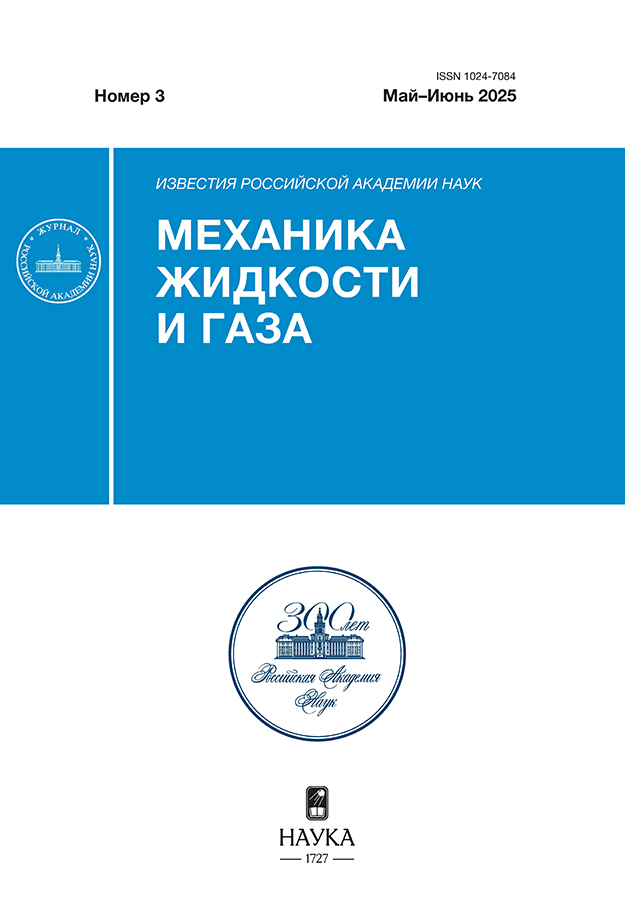Comparison of the Eulerian and Lagrangian Approaches to Studying the Peculiarities of the Interstellar Dust Distribution in the Heliosphere in the Framework of the Cold Gas Model
- Authors: Godenko E.A.1,2,3, Izmodenov V.V.1,2,3
-
Affiliations:
- Ishlinsky Institute for Problems in Mechanics of the Russian Academy of Sciences
- Space Research Institute of the Russian Academy of Science
- Moscow State University
- Issue: No 2 (2023)
- Pages: 138-150
- Section: Articles
- URL: https://journals.rcsi.science/1024-7084/article/view/135095
- DOI: https://doi.org/10.31857/S0568528122600783
- EDN: https://elibrary.ru/NTGHJS
- ID: 135095
Cite item
Full Text
Abstract
Interstellar dust grains penetrate into the heliosphere (region in which the solar wind propagates) due to the relative motion of the Sun and the Local Interstellar Medium (LISM). Inside the heliosphere, the motion of dust particles is mainly governed by the electromagnetic force determined by the heliospheric magnetic field. Under the action of this force, the trajectories of dust grains experience intersections with each other and self-intersections. As a result, dust density accumulation regions appear. These regions are of a great interest in the context of theoretical studying and planning of upcoming space missions. The main aim of the present study is to model the interstellar dust distribution in the heliosphere and investigate the peculiarities of the number density distribution. To describe the dusty component, the cold gas model is used, while to compute the interstellar dust distribution two approaches are considered, namely, the Eulerian and Lagrangian approaches. For solving the continuity equation in the Lagrangian coordinates, the full Lagrangian method or the Osiptsov method is used. As a result, all the peculiarities of the dust distribution are investigated and it is found that they are located on caustics, i.e., the envelopes of interstellar dust trajectories. Besides it, the regular regions of overdensity (without singularities in the number density) are discovered. It is shown that the dust component accumulation regions are located in a small neighborhood of the heliospheric current sheet, at which the magnetic field changes its polarity, and in the tail of the heliosphere. The effectiveness of the Osiptsov method of solving the continuity equation is compared with the widely used Monte Carlo method (Eulerian approach). It is shown that Monte Carlo method requires extremely high resolution of computational grid to reach the level of accuracy comparable with the Osiptsov method.
Keywords
About the authors
E. A. Godenko
Ishlinsky Institute for Problems in Mechanics of the Russian Academy of Sciences; Space Research Institute of the Russian Academy of Science; Moscow State University
Email: godenko.egor@yandex.ru
Moscow, Russia; Moscow, Russia ; Moscow, Russia
V. V. Izmodenov
Ishlinsky Institute for Problems in Mechanics of the Russian Academy of Sciences; Space Research Institute of the Russian Academy of Science; Moscow State University
Author for correspondence.
Email: godenko.egor@yandex.ru
Moscow, Russia; Moscow, Russia; Moscow, Russia
References
- Grun E., Zook H.A., Baguhl M., Balogh A., Fechtig H., Forsyth R., Hanner M.S., Horanyi M., Kissel J., Lindblad B.-A., Linkert D. Linkert G., Mann I., McDonnell J.A.M., Morfill G.E., Phillips J.L., Polanskey C., Schwehm G., Siddique N., Staubach P., Svestka J., Taylor A. Discovery of Jovian dust streams and interstellar grains by the Ulysses spacecraft // Nature. 1993. V. 362. P. 428–430. https://doi.org/10.1038/362428a0
- Altobelli N., Postberg F., Fiege K., Trieloff M., Kimura H., Sterken V.J., Hsu H.-W., Hillier J., Khawaja N., Moragas-Klostermeyer G., Blum J., Burton M., Srama R., Kempf S., Grun E. Flux and composition of interstellar dust at Saturn from Cassini’s Cosmic Dust Analyzer // Science. 2016. V. 352. № 6283. P. 312–318. https://doi.org/10.1126/science.aac6397
- Westphal A.J., Stroud R.M., Bechtel H.A., Brenker F.E., Butterworth A.L., Flynn G.J., Frank D.R., Gainsforth Z., Hillier J.K., Postberg F., Simionovici A.S., Sterken V.J., Nittler L.R., Allen C., Anderson D., Ansari A., Bajt S., Bastien R.K., Bassim N., Bridges J., Brownlee D.E., Burchell M., Burghammer M., Changela H., Cloetens P., Davis A.M., Doll R., Floss C., Grun E., Heck P.R., Hoppe P., Hudson B., Huth J., Kearsley A., King A.J., Lai B., Leitner J., Lemelle L., Leonard A., Leroux H., Lettieri R., Marchant W., Ogliore R., Ong W.J., Price M.C., Sandford S.A., Tresseras J.-A.S., Schmitz S., Schoonjans T., Schreiber K., Silversmit G. Solé V.A., Srama R., Stadermann F., Stephan T., Stodolna J., Sutton S., Trieloff M., Tsou P., Tyliszczak T., Vekemans B., Vincze L., Von Korff J., Wordsworth N., Zevin D., Zolensky M.E. Evidence for interstellar origin of seven dust particles collected by the Stardust spacecraft // Science. 2014. V. 345. № 6198. P. 786–791. https://doi.org/10.1126/science.1252496
- Bertaux J.L., Blamont J.E. Possible evidence for penetration of interstellar dust into the Solar System // Nature. 1976. V. 262. № 5566. P. 263–266. https://doi.org/10.1038/262263a0
- Levy E.H., Jokipii J.R. Penetration of interstellar dust into the solar system // Nature. 1976. V. 264. P. 423. https://doi.org/10.1038/264423a0
- Sterken V.J., Altobelli N., Kempf S., Kruger H., Srama R., Strub P., Grun E. The filtering of interstellar dust in the solar system // Astronomy and Astrophysics. 2013. V. 552. P. A130. https://doi.org/10.1051/0004-6361/201219609
- Morfill G.E., Grun E. The motion of charged dust particles in interplanetary space - II. Interstellar grains // Planetary and Space Science. 1979. V. 27. № 10. P. 1283–1292. https://doi.org/10.1016/0032-0633(79)90106-5
- Landgraf M. Modeling the motion and distribution of interstellar dust inside the heliosphere // Journal of Geophysical Research. 2000. V. 105. № A5. P. 10303–10316. https://doi.org/10.1029/1999JA900243
- Linde T.J., Gombosi T.I. Interstellar dust filtration at the heliospheric interface // Journal of Geophysical Research. 2000. V. 105. № A5. P. 10411–10418. https://doi.org/10.1029/1999JA900149
- Sterken V.J., Altobelli N., Kempf S., Schwehm G., Srama R., Grun E. The flow of interstellar dust into the solar system // Astronomy and Astrophysics. 2012. V. 538. P. A102. https://doi.org/10.1051/0004-6361/201117119
- Slavin J.D., Frisch P.C., Muller H.-R., Heerikhuisen J., Pogorelov N.V., Reach W.T., Zank G. Trajectories and Distribution of Interstellar Dust Grains in the Heliosphere // The Astrophysical Journal. 2012. V. 760. № 1. P. 46. https://doi.org/10.1088/0004-637X/760/1/46
- Alexashov D.B., Katushkina O.A., Izmodenov V.V., Akaev P.S. Interstellar dust distribution outside the heliopause: deflection at the heliospheric interface // MNRAS. 2016. V. 458. № 3. P. 2553–2564. https://doi.org/10.1093/mnras/stw514
- Godenko E.A., Izmodenov V.V. Effects of Dispersion of the Dust Velocity in the LISM on the Interstellar Dust Distribution inside the Heliosphere // Astronomy Letters. 2021. V. 47. № 1. P. 50–60. https://doi.org/10.1134/S1063773721010047
- Healy D.P., Young J.B. Full Lagrangian methods for calculating pconcentration fields in dilute gas-pflows // Proceedings of the Royal Society of London Series A. 2005. V. 461. № 2059. P. 2197–2225. https://doi.org/10.1098/rspa.2004.1413
- Osiptsov A.N. Full Lagrangian Modelling of Dust Admixture in Gas Flows // Astrophysics and Space Science. 2000. V. 274. P. 377–386. https://doi.org/10.1023/A:1026557603451
- Лебедева Н.А., Осипцов А.Н. Течения вблизи критических точек при несимметричном столкновении вязких дисперсных потоков // Изв. РАН. МЖГ. 2007. № 5. С. 85–97.
- Ahuja R., Belonoshko A.B., Johansson B., Osiptsov A.N. Inertial phase separation in rotating self-gravitating media // Fluid Dynamics. 2004. V. 39. № 6. P. 920–932. https://doi.org/10.1007/s10697-005-0027-2
- Mishchenko A.V., Godenko E.A., Izmodenov V.V. Lagrangian fluid approach for the modelling of peculiarities of the interstellar dust distribution in the astrospheres/heliosphere // MNRAS. 2020. V. 491. № 2. P. 2808–2821. https://doi.org/10.1093/mnras/stz3193
- Hoang T., Lazarian A., Schlickeiser R. Revisiting Acceleration of Charged Grains in Magnetohydrodynamic Turbulence // The Astrophysical Journal. 2012. V. 747. № 1. P. 54. https://doi.org/10.1088/0004-637X/747/1/54
- Баранов В.Б., Измоденов В.В. Модельные представления о взаимодействии солнечного ветра со сверхзвуковым потоком межзвездной среды. Предсказание и интерпретация экспериментальных данных // Изв. РАН. МЖГ. 2006. № 5. С. 19–40.
- Izmodenov V.V., Alexashov D.B. Magnitude and direction of the local interstellar magnetic field inferred from Voyager 1 and 2 interstellar data and global heliospheric model // Astronomy and Astrophysics. 2020. V. 633. P. L12. https://doi.org/10.1051/0004-6361/201937058
- van Marle A.J., Meliani Z., Keppens R., Decin L. Computing the Dust Distribution in the Bow Shock of a Fast-moving, Evolved Star // The Astrophysical Journal Letters. 2011. V. 734. № 2. P. L26. https://doi.org/10.1051/0004-6361/201937058
- Greenberg J.M., Li A. What are the true astronomical silicates? // Astronomy and Astrophysics. 1996. V. 309. P. 258–266.
- Parker E.N. Dynamics of the Interplanetary Gas and Magnetic Fields // The Astrophysical Journal. 1958. V. 128. P. 664. https://doi.org/10.1086/146579
Supplementary files


















